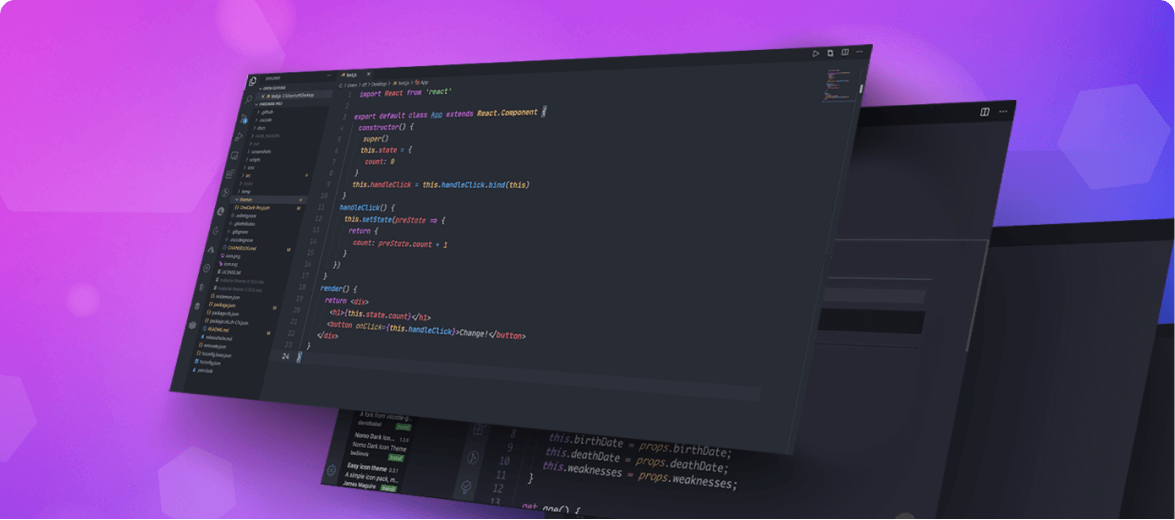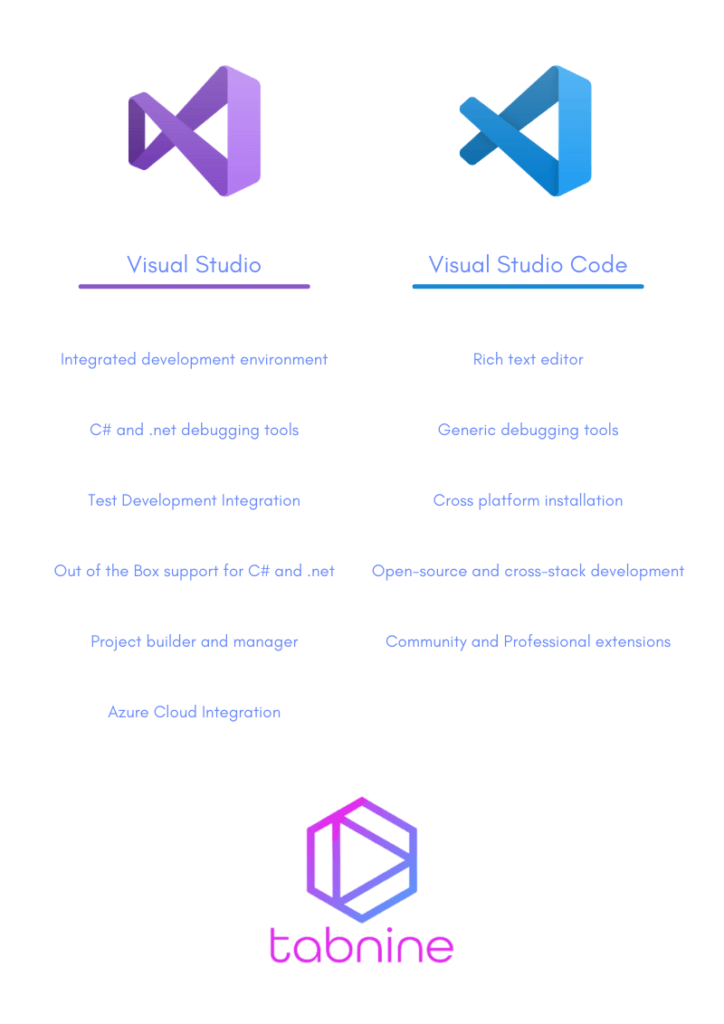
Nobody will fault you for confusing the two editors made by Microsoft, seeing as they pretty much have the same name. However, aside from the common name, they have a somewhat different set of features.
Let’s diffuse this cloud of confusion. Before getting deeper into the specifics, the main distinction between these editors is that Visual Studio is a full-fledged Integrated Development Environment (IDE), while Visual Studio Code is a rich text editor. This primary difference sets them apart and is why you might choose one over the other.
Visual Studio was first released back in 1997 as a bundle of programming tools. Today, Visual Studio is Microsoft’s made-to-measure development environment for everything C# and .net. Essentially, Microsoft set out to develop an IDE that will make it as convenient as possible for their in-house developers and anyone who wants to use C# and .net. Since it is a Microsoft IDE, it naturally integrates well into the Microsoft ecosystems such as Azure. While the base software is feature-rich, you can enhance it with plugins developed by both Microsoft and third parties. Visual Studio is ready out of the box for C# and .net developers.
The latest version of Visual Studio at the time of writing is 17.1.0 and was released in February 2022. According to previous releases, you can expect a new version at least once a quarter.
Visual Studio Code, first released in 2015, is an open-source rich text editor that runs on Windows, macOS, and Linux. Unlike Visual Studio, VSCode is a much lighter installation that needs to take advantage of plugins for a better coding experience. You could use VSCode as is for development, but you might find some features you expect from an IDE to be missing, such as auto-completion, syntax highlighter, code linters and smart compilers. VSCode is best suited for developers who are comfortable tweaking their environment to suit their needs because they will likely have to.
According to a StackOverflow survey conducted in May 2021, Visual Studio Code is by far the most popular IDE, which is interesting since it isn’t quite an IDE. Visual Studio Code seems to skirt the gap between a rich text editor and a full-fledged IDE.
The latest version of Visual Studio Code at the time of writing is 1.63.2 and was released December 20th 2021. According to previous releases, you can expect a new version at least once a quarter.
It’s essential to remain informed about new technologies and practices to excel in this constantly evolving industry. Learn how you can leverage AI to optimize your software engineering in 2023.
Visual Studio has more features than Visual Studio Code. Here are the differences you would want to keep in mind when choosing one over the other.
Visual Studio’s Build settings and output folders are some of the most important and noticeable features in an IDE that aren’t available in a rich text editor. Usually, when using a rich text editor, you write the code and then send it to a server to be compiled and run. In an IDE, you can compile and run your code inside the editor.
Well-integrated debugging tools are gold, and Visual Studio has all the tools you need. Place breakpoints, step through and over methods, etc. Once you’ve worked with an excellent debugging tool, it is hard to go back to working without one.
While not as powerful as the Visual Studio’s debugger, the one shipped with Visual Studio Code is still useful. The thing to know is that the Visual Studio Code debugger can be easily extended to cover many languages, while the Visual Studio debugger is most potent with C# and .net.
Project Builder for C# and .NET apps
Visual Studio’s Project Builder is a powerful tool at your disposal. Having context parameters, aggregating different code areas, and switching between various projects are all made easier with project management.
Azure Cloud integrations
If you’re working with Azure cloud, an integrated connection will make your development far more manageable. The Azure Cloud integration available in Visual Studio may be a deciding factor when choosing between the two editors. If you’re using Azure, this feature will be hard to pass up.
Test Development Integrations
Visual Studio has robust Test Development integration. Not everyone uses unit testing, but if you do, then having the process integrated into your IDE makes it far more accessible and, as such, more likely to be done and done well.
Open-source software means that Visual Studio Code is adaptable to the developer’s needs. It is easier to develop plugins for it and incorporate the existing work of others. If you’re looking for cross-stack development or work on multiple projects in different languages, you should not overlook this feature.
One of the main selling points of rich text editors is that they are lightweight. This means they offer fewer features out of the box but are more extensible. Visual Studio Code has a marketplace chock-full of great extensions. Using those extensions, you can tailor your editor to your specific needs.
Visual Studio runs on Windows and macOS, but Visual Studio Code also runs on Linux. Sometimes you may need this flexibility, and sometimes you may be running everything on Linux, leaving you with little choice over the matter.ֿ

When approaching the question of which to choose between Visual Studio and Visual Studio Code, you need to consider, first and foremost, your needs. If your needs are specific to C# or .net development, you’re almost certainly better off trusting Microsoft to have to build an excellent IDE for your needs. On the other hand, if you’re looking for cross-stack development, then a highly customizable rich text editor may be preferable. Then again, you might be a developer that prefers to customize your experience regardless.
[cta_btn url=”https://www.tabnine.com/pricing/landing” label=”Start a free trial”]